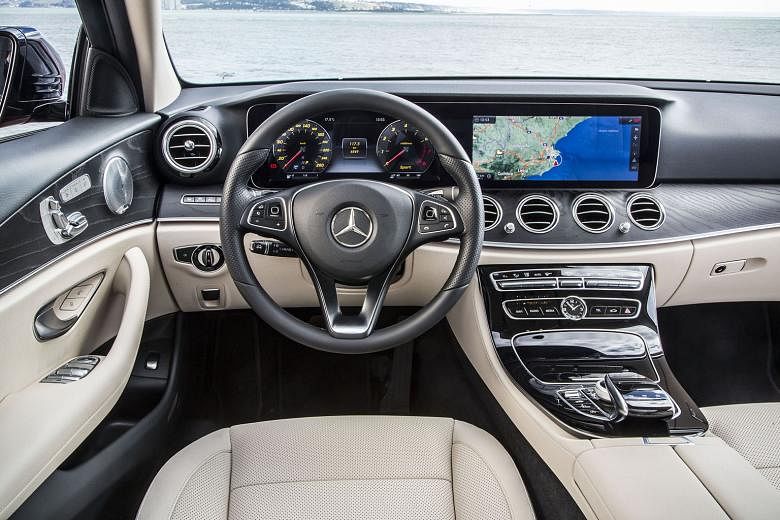The Mercedes-Benz E-class appeals to a wide range of people in Singapore, from company executives to towkays and taxi fleet operators.
The latest model, which is expected to arrive in showrooms in Singapore in the third quarter of this year, will broaden its appeal, finding new fans among those who not only want a stately, comfortable sedan, but also enjoy driving as well.
Techies should also love the car.
Visually, the new E looks like a mini S-class or a larger C-class, sharing their coupe-like rooflines, sharp flanks and smooth silhouettes. It is 43mm longer than its predecessor (4,923mm versus 4,880mm), but 2mm slimmer (1,852mm versus 1,854mm). It has a slightly lower profile (1,468mm versus 1,471mm).
The most significant change is the 65mm addition to its wheelbase (2,939mm versus 2,874mm), making the already roomy rear row even more limousine-like.
-
SPECS/MERCEDES-BENZ E300
Price: To be announced
Engine: 1,991cc 16-valve inline-4 turbocharged
Transmission: Nine-speed automatic with manual select
Power: 245bhp at 5,500rpm
Torque: 370Nmat 1,200-4,000rpm
0-100kmh: 6.3 seconds
Top speed: 250kmh
Fuel consumption: 6.6 litres/100km
Agent: Cycle&Carriage
The entry-level E200 is powered by a 184bhp/300Nm 2-litre, four- cylinder turbocharged petrol engine carried over from its predecessor. This version was not available for test-drive.
I took the E300 - which replaces the current E250 - through its paces over 100km of city and country roads. It is powered by the same 2-litre engine as the E200, but has 245bhp and 370Nm. It is also quicker in the century sprint (6.3 versus 7.7 seconds).
While the power plant may be the same, the new E does not drive like the current one, thanks to its new transmission and chassis.
There are four drive modes: Eco, Comfort, Sports and Sports Plus.
The Comfort mode is where the traditional E-class qualities shine. It glides over potholes in the countryside and cobblestones in the city.
The Sports Plus mode delays gear shifts and sharpens the steering response, making the car acutely sensitive to steering inputs, which is unusual for the E-class.
Along the narrow, winding roads of the Sintra Mountains on the outskirts of Lisbon, this mode allowed me to pilot the car confidently and effortlessly around sharp curves and sweeping corners.
The test car had air suspension that automatically varies damping according to driving conditions.
It also allows drivers to raise the ride height for better ground clearance on unpaved roads. Mercedes-Benz boasts that it is the only premium executive sedan that has this option. Merc's nine-speed automatic transmission, an upgrade from the seven-speeder found in most of its models, is capable. It always puts the car in the right gear, rendering paddle shifters redundant for most drivers.
In the cabin, the new E is a dead ringer for the S-class, from the way the cockpit is laid out to the quality of the perforated leather.
The most arresting feature is a pair of two 12.3-inch digital instrument displays. Laid side-by-side, they provide all the information that drivers would conceivably need, from speed to engine temperature and navigation instructions.
Passengers enjoy 64 different choices for interior lighting, outdoing even the S-class, which has only eight options.
Overall, key changes such as sharper design, larger space and enhanced driveability ought to retain old customers and win new ones.
But if these upgrades are not enough, the new E has new tricks in its bag.
Three are worth highlighting: remote parking, automatic lane changing and allowing the owner to use his smartphone as car key.
You can tap your phone on the door handle to unlock the door. To start the engine, the driver merely steps on the brake pedal and pushes the ignition button. This does away with the key fob completely. There is even a designated spot in the centre console where the smartphone can be charged wirelessly.
Drivers can also use the phone to park the car without being inside it - which is useful at places such as Shaw House, where parking spaces are notoriously tight.
(There are initial kinks to be resolved - the smartphone that was used as a digital key was an Android device while the remote parking software ran on an iPhone.)
The third cool trick is automatic lane changing. I flicked the signal stalk when the car was in the self-driving mode and the car took over. It used radar to detect gaps in traffic and slid into them in a steady and confident fashion.
The new E also taps on technology to keep drivers and passengers safe. Rear passengers get three "belt bags" - seat belts that inflate to become mini airbags.
In a side collision, the side bolsters of the front seats move occupants about two inches inwards, away from the point of impact.
The car even uses its hi-fi system to emit a sound just before impact which supposedly puts the ears in a reflex protective mode, thereby reducing the risk of hearing loss.
When the latest-generation E-class arrives in Singapore, the gizmos will likely be pared down, either to lower the price of the car or to avoid regulatory hurdles (I wonder how the authorities will view the self-parking and lane- changing functions).
Even without these functions, the new E is an improvement over the current model. It offers enhanced driveability in a comfortable and luxurious package.
But the verdict is still out on whether the base E200 will be as comfortable as the test car which had air suspension.



